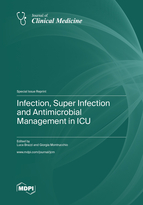Infection, Super Infection and Antimicrobial Management in ICU
A special issue of Journal of Clinical Medicine (ISSN 2077-0383). This special issue belongs to the section "Intensive Care".
Deadline for manuscript submissions: closed (20 March 2023) | Viewed by 17862
Special Issue Editors
Interests: intensive care medicine; critical care medicine; ARDS; airway management; resuscitation; mechanical ventilation; extracorporeal support
Special Issues, Collections and Topics in MDPI journals
2. Department of Anaesthesia, Intensive Care and Emergency, ‘Città della Salute e della Scienza’ University Hospital, 10126 Turin, Italy
Interests: infections; antimicrobial treatment; clinical biomarkers; intensive care medicine; critical care medicine; extracorporeal support; ARDS
Special Issues, Collections and Topics in MDPI journals
Special Issue Information
Dear Colleagues,
Although there is growing evidence covering their relevance, the prevalence and microbiology characteristics of bacterial superinfections in critically ill COVID-19 patients are not yet completely understood.
It is instead fully recognized that in patients affected by severe viral respiratory tract infections, the presence of a concomitant infection is associated with poor clinical outcomes. For example, in patients with influenza, superimposed bacterial infections are present in 20–30% of patients, and this condition is associated with increased rates of shock, mechanical ventilation, and mortality. Similarly, in 2003, for the SARS-CoV epidemic, an increased rate of Methicillin-resistant Staphylococcus aureus (MRSA) was reported from 3.53% (3.53 cases per 100 admissions) of cases during the pre-SARS period to 25.3% during the SARS period, with an increased rate of ventilator-acquired pneumonia in ICUs, which was mostly (47.1%) caused by MRSA.
Currently, the pathogens causing secondary infections in SARS-CoV-2 patients seem to be diverse: negative bacilli were the most common, followed by MRSA and Candida.
Assessing the risk of difficult-to-treat bacterial superinfections, such as multidrug-resistant (MDR) Gram-negative bacilli, according to comorbidities, lung abnormalities or systemic diseases, the severity of pneumonia and the risks of drug-related effects are crucial points for the clinical management.
Despite the wide—and not always appropriate—use of broad-spectrum antimicrobials, specific data about bacterial and fungal co-infection in COVID-19 patients are lacking, and confirmed evidence is urgently required to build prospective evidence and to support the development of antimicrobial policy and appropriate stewardship interventions.
The present Special Issue aims to focus on the following key points:
- Importance of superinfections in COVID-19 patients who are typically characterized by immunosuppression related to viral infection, need for prolonged hospitalization, treatment with immunomodulatory therapies (steroids, monoclonal antibodies, etc.);
- Their impact on the outcome of a cohort of patients who are relatively young, with few comorbidities, but requiring prolonged invasive support;
- Incidence, characteristics and impact of bacterial infections caused by multidrug-resistant, Gram-negative pathogens in the context of COVID-19 disease;
- Incidence, characteristics and impact of fungal infections, such as the most known invasive aspergillosis but also candidemia and/or other fungal infections (e.g., mucormycosis);
- Antimicrobial surveillance, control and management measures as implemented on a local, national and international basis.
Prof. Dr. Luca Brazzi
Dr. Giorgia Montrucchio
Guest Editors
Manuscript Submission Information
Manuscripts should be submitted online at www.mdpi.com by registering and logging in to this website. Once you are registered, click here to go to the submission form. Manuscripts can be submitted until the deadline. All submissions that pass pre-check are peer-reviewed. Accepted papers will be published continuously in the journal (as soon as accepted) and will be listed together on the special issue website. Research articles, review articles as well as short communications are invited. For planned papers, a title and short abstract (about 100 words) can be sent to the Editorial Office for announcement on this website.
Submitted manuscripts should not have been published previously, nor be under consideration for publication elsewhere (except conference proceedings papers). All manuscripts are thoroughly refereed through a single-blind peer-review process. A guide for authors and other relevant information for submission of manuscripts is available on the Instructions for Authors page. Journal of Clinical Medicine is an international peer-reviewed open access semimonthly journal published by MDPI.
Please visit the Instructions for Authors page before submitting a manuscript. The Article Processing Charge (APC) for publication in this open access journal is 2600 CHF (Swiss Francs). Submitted papers should be well formatted and use good English. Authors may use MDPI's English editing service prior to publication or during author revisions.
Keywords
- superinfections
- COVID-19
- SARS-CoV-2
- multidrug-resistant pathogens
- antimicrobial stewardship
- antimicrobial resistance
- fungal infections
- bacterial infections
- intensive care medicine
- critical care medicine








